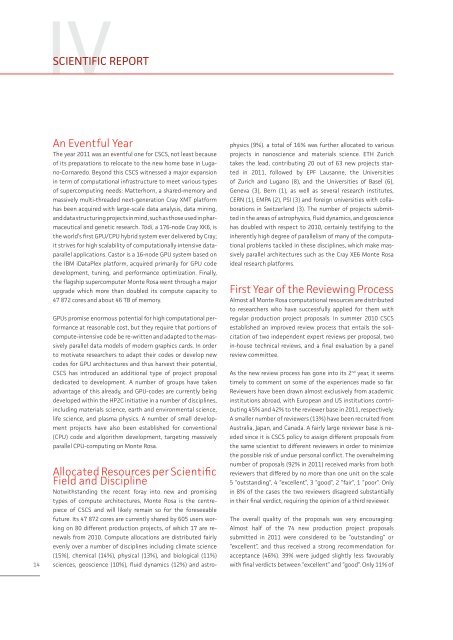Annual Report 2011 - CSCS
Annual Report 2011 - CSCS
Annual Report 2011 - CSCS
Create successful ePaper yourself
Turn your PDF publications into a flip-book with our unique Google optimized e-Paper software.
14<br />
IV<br />
SCIENTIFIC REPORT<br />
An Eventful Year<br />
The year <strong>2011</strong> was an eventful one for <strong>CSCS</strong>, not least because<br />
of its preparations to relocate to the new home base in Lugano-Cornaredo.<br />
Beyond this <strong>CSCS</strong> witnessed a major expansion<br />
in term of computational infrastructure to meet various types<br />
of supercomputing needs: Matterhorn, a shared-memory and<br />
massively multi-threaded next-generation Cray XMT platform<br />
has been acquired with large-scale data analysis, data mining,<br />
and data structuring projects in mind, such as those used in pharmaceutical<br />
and genetic research. Tödi, a 176-node Cray XK6, is<br />
the world’s first GPU/CPU hybrid system ever delivered by Cray;<br />
it strives for high scalability of computationally intensive dataparallel<br />
applications. Castor is a 16-node GPU system based on<br />
the IBM iDataPlex platform, acquired primarily for GPU code<br />
development, tuning, and performance optimization. Finally,<br />
the flagship supercomputer Monte Rosa went through a major<br />
upgrade which more than doubled its compute capacity to<br />
47 872 cores and about 46 TB of memory.<br />
GPUs promise enormous potential for high computational performance<br />
at reasonable cost, but they require that portions of<br />
compute-intensive code be re-written and adapted to the massively<br />
parallel data models of modern graphics cards. In order<br />
to motivate researchers to adapt their codes or develop new<br />
codes for GPU architectures and thus harvest their potential,<br />
<strong>CSCS</strong> has introduced an additional type of project proposal<br />
dedicated to development. A number of groups have taken<br />
advantage of this already, and GPU-codes are currently being<br />
developed within the HP2C initiative in a number of disciplines,<br />
including materials science, earth and environmental science,<br />
life science, and plasma physics. A number of small development<br />
projects have also been established for conventional<br />
(CPU) code and algorithm development, targeting massively<br />
parallel CPU-computing on Monte Rosa.<br />
Allocated Resources per Scientific<br />
Field and Discipline<br />
Notwithstanding the recent foray into new and promising<br />
types of compute architectures, Monte Rosa is the centrepiece<br />
of <strong>CSCS</strong> and will likely remain so for the foreseeable<br />
future. Its 47 872 cores are currently shared by 605 users working<br />
on 80 different production projects, of which 17 are renewals<br />
from 2010. Compute allocations are distributed fairly<br />
evenly over a number of disciplines including climate science<br />
(15%), chemical (14%), physical (13%), and biological (11%)<br />
sciences, geoscience (10%), fluid dynamics (12%) and astro-<br />
physics (9%). a total of 16% was further allocated to various<br />
projects in nanoscience and materials science. ETH Zurich<br />
takes the lead, contributing 20 out of 63 new projects started<br />
in <strong>2011</strong>, followed by EPF Lausanne, the Universities<br />
of Zurich and Lugano (8), and the Universities of Basel (6),<br />
Geneva (3), Bern (1), as well as several research institutes,<br />
CERN (1), EMPA (2), PSI (3) and foreign universities with collaborations<br />
in Switzerland (3). The number of projects submitted<br />
in the areas of astrophysics, fluid dynamics, and geoscience<br />
has doubled with respect to 2010, certainly testifying to the<br />
inherently high degree of parallelism of many of the computational<br />
problems tackled in these disciplines, which make massively<br />
parallel architectures such as the Cray XE6 Monte Rosa<br />
ideal research platforms.<br />
First Year of the Reviewing Process<br />
Almost all Monte Rosa computational resources are distributed<br />
to researchers who have successfully applied for them with<br />
regular production project proposals. In summer 2010 <strong>CSCS</strong><br />
established an improved review process that entails the solicitation<br />
of two independent expert reviews per proposal, two<br />
in-house technical reviews, and a final evaluation by a panel<br />
review committee.<br />
As the new review process has gone into its 2nd year, it seems<br />
timely to comment on some of the experiences made so far.<br />
Reviewers have been drawn almost exclusively from academic<br />
institutions abroad, with European and US institutions contributing<br />
45% and 42% to the reviewer base in <strong>2011</strong>, respectively.<br />
A smaller number of reviewers (13%) have been recruited from<br />
Australia, Japan, and Canada. A fairly large reviewer base is needed<br />
since it is <strong>CSCS</strong> policy to assign different proposals from<br />
the same scientist to different reviewers in order to minimize<br />
the possible risk of undue personal conflict. The overwhelming<br />
number of proposals (92% in <strong>2011</strong>) received marks from both<br />
reviewers that differed by no more than one unit on the scale<br />
5 “outstanding”, 4 “excellent”, 3 “good”, 2 “fair”, 1 “poor”. Only<br />
in 8% of the cases the two reviewers disagreed substantially<br />
in their final verdict, requiring the opinion of a third reviewer.<br />
The overall quality of the proposals was very encouraging:<br />
Almost half of the 74 new production project proposals<br />
submitted in <strong>2011</strong> were considered to be “outstanding” or<br />
“excellent”, and thus received a strong recommendation for<br />
acceptance (46%). 39% were judged slightly less favourably<br />
with final verdicts between “excellent” and “good”. Only 11% of


